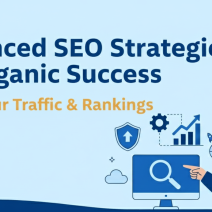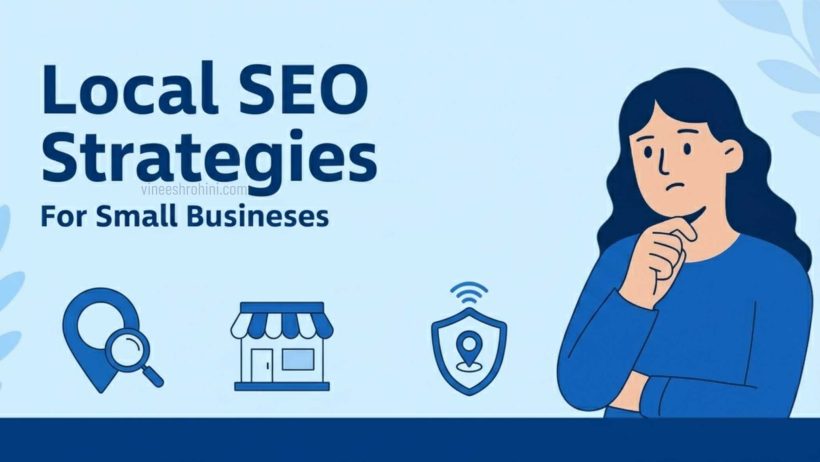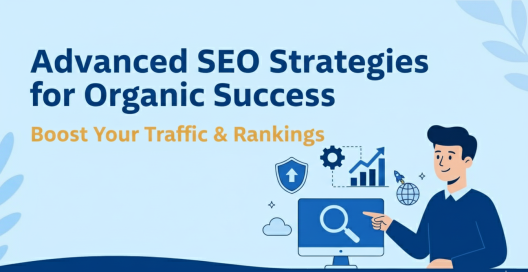Local SEO Strategies : In today’s digital-first economy, visibility on the internet determines whether a business thrives or disappears in competition. For small businesses that depend on local customers, search visibility has become the foundation of success. Local SEO, or Local Search Engine Optimization, ensures that when potential customers search for services near them, your business shows up first. In 2025, Local SEO is more advanced and essential than ever, driven by AI-powered search engines, voice search dominance, mobile-first indexing, and hyper-local personalization.
Table of Contents
Small businesses that strategically invest in Local SEO can compete with large brands by connecting with nearby customers at the exact moment of intent. This comprehensive guide explores Local SEO strategies for small businesses in 2025, how algorithms have evolved, and the best ways to optimize for local searches to gain real-world results.
Understanding Local SEO and Its Importance

Local SEO is the process of optimizing your online presence so that your business appears in local search results when people look for nearby products or services. For example, if someone searches “best bakery near me” or “plumber in Kochi,” search engines like G display nearby businesses based on relevance, distance, and prominence. Local SEO focuses on enhancing all three. It’s vital because 46% of all G searches are seeking local information, and 76% of local mobile searches result in a visit to a business within 24 hours.
Also Read : Launch Your Online Clothing Business Online – From Start to Success – Comprehensive Guide 2025 – Get eBook.
For small businesses, this represents a massive opportunity to capture customers who are ready to buy. As G continues refining local search algorithms with AI and real-time intent detection, optimizing your business for local SEO in 2025 ensures sustainable growth and visibility in your community.
The Evolution of Local SEO in 2025
In earlier years, Local SEO primarily depended on G My Business listings and backlinks from local directories. However, in 2025, G ’s algorithm updates have made Local SEO more sophisticated, relying on AI intent analysis, conversational search, and location-based personalization. The emergence of G Business Profile 2.0, real-time reviews, voice search, and local schema markup have changed the landscape completely. G now prioritizes businesses that provide accurate, structured data and consistent online credibility. Additionally, mobile-first indexing and AI-driven map results mean that businesses must optimize their local SEO across multiple devices and platforms. Understanding these trends is crucial for small businesses aiming to dominate local searches.
1. Optimize Your G Business Profile (GBP)
The foundation of any Local SEO strategy begins with optimizing your G Business Profile. Formerly known as G My Business (GMB), GBP remains the most influential factor for local search rankings. Your profile acts as your business’s digital storefront on GSearch and Maps. To optimize effectively in 2025, ensure your business information — including name, address, phone number (NAP), website, hours, and category — is 100% accurate and consistent across all platforms.
Use high-quality images, add product or service listings, and frequently update posts to showcase new offers or events. G now allows video uploads, FAQs, and appointment booking integrations directly within GBP. Encourage satisfied customers to leave authentic reviews and respond to them promptly. G’s algorithm gives higher visibility to businesses that maintain an active, engaging, and verified profile.
2. Build Consistent NAP Citations Across the Web
Citations are mentions of your business details (Name, Address, Phone number) across directories, social platforms, and websites. Inconsistent NAP details can confuse search engines and harm your rankings. Use major business directories such as Yelp, Bing Places, Yellow Pages, Justdial, and IndiaMart to ensure consistent information everywhere. Tools like Moz Local, BrightLocal, or Yext can help you manage citations efficiently. Beyond standard directories, include your NAP on local blogs, chamber of commerce websites, and community portals. Consistency signals trust to G and reinforces your business’s legitimacy within local search ecosystems.
3. Use Localized Keywords and Geo-Targeted Content
Keyword optimization is the backbone of SEO, and in Local SEO, location-based keywords are essential. For example, instead of targeting “digital marketing services,” use “digital marketing services in Kochi” or “best digital marketing agency near Ernakulam.” Use tools like G Keyword Planner, Ahrefs, or SEMrush to identify local search queries relevant to your area. Create localized landing pages optimized for these keywords and incorporate them naturally into titles, meta descriptions, and headers. In 2025, G’s AI understands user intent deeply, so focus on conversational and long-tail local keywords such as “where can I find the best café in Trivandrum.” Including regional terms, nearby landmarks, or service areas can enhance relevance and boost visibility in “near me” searches.
4. Leverage AI-Powered Voice Search Optimization
Voice search has revolutionized local SEO, especially with devices like G Assistant, Siri, and Alexa. More than 58% of consumers now use voice search to find local business information. In 2025, optimizing for voice queries means writing in a conversational tone and focusing on natural language. Create content that answers common questions users might ask, such as “What’s the best salon open now near me?” or “Where can I buy organic groceries in Thrissur?” Add structured data markup (Schema) to your site to help G understand your content better. Implement FAQ sections with direct, concise answers and ensure your website loads quickly on mobile, as most voice searches come from smartphones.
5. Optimize for Mobile and Page Speed
Since most local searches happen on mobile devices, your website must provide a flawless mobile experience. G prioritizes mobile-friendly, fast-loading websites in local search rankings. Use responsive design, optimize image sizes, enable browser caching, and leverage Core Web Vitals to enhance performance. Tools like G PageSpeed Insights and GTmetrix can analyze and suggest improvements. A smooth mobile interface not only boosts SEO but also reduces bounce rates and improves user engagement, both of which are ranking signals for G’s local search algorithm.
6. Create Location-Specific Landing Pages
If your small business serves multiple cities or regions, create dedicated landing pages for each area. Each page should include localized keywords, customer testimonials, nearby landmarks, embedded G Maps, and city-specific information. Avoid duplicating content across these pages; instead, personalize each one based on local culture, community involvement, and events. For example, a restaurant chain could create separate pages like “Best Seafood Restaurant in Kochi” and “Top Seafood Dining in Calicut.” This strategy helps target diverse audiences and strengthens regional SEO signals.
7. Acquire Local Backlinks and Collaborations
Backlinks remain a core SEO factor, and acquiring them from local sources increases your authority in specific regions. Collaborate with local bloggers, news websites, and community portals to get featured. Sponsor local events, charities, or festivals and request backlinks in event listings. Join local business associations and get listed on their online directories. Guest posting on local niche blogs or creating press releases about community projects can generate high-quality local backlinks. In 2025, relevance outweighs volume — a few strong, location-based backlinks can outperform hundreds of generic ones.
8. Encourage and Manage Online Reviews
Online reviews are among the most powerful ranking and trust-building tools for small businesses. According to G’s 2025 ranking factors, review quality, frequency, and response rate heavily influence local SEO performance. Encourage happy customers to leave reviews on G Business Profile, FB, and other review platforms. Automate review requests through email or SMS after a purchase or service. Always respond to reviews — both positive and negative — professionally and promptly. A consistent flow of genuine reviews signals to G that your business is active and reliable. Avoid fake reviews, as G’s AI review detection is now highly sophisticated.
9. Implement Local Business Schema Markup
Schema markup is structured data added to your website to help search engines better understand your content. Implementing LocalBusiness schema provides detailed information like business type, address, ratings, and operating hours directly in search results. This enhances visibility through rich snippets, featured listings, and map packs. Tools like G’s Structured Data Markup Helper can simplify this process. Schema markup is particularly effective for restaurants, healthcare services, and service providers that rely heavily on local customers.
10. Utilize Social Media for Local Engagement

Social media platforms play a crucial role in modern local SEO. Maintaining an active presence on FB, Insta, LinkedIn, and Twitter not only improves brand visibility but also strengthens local community engagement. Use location tags, hashtags, and geo-targeted ads to reach nearby audiences. Share updates about local events, offers, or partnerships, and encourage customers to tag your location in their posts. In 2025, G increasingly factors social signals and brand engagement into local ranking decisions, making social media an essential part of your SEO mix.
11. Create Locally Relevant Blog Content
Creating blog content centered around local interests and events builds both engagement and SEO authority. Write about local festivals, neighborhood guides, community initiatives, or partnerships with nearby businesses. For instance, a fitness studio might post an article titled “Top Outdoor Workout Spots in Chennai.” Adding local insights, interviews, or case studies increases relevance. Incorporate local keywords and internal links to your main service pages for added SEO value. Consistent, localized content establishes your business as a community authority while attracting organic traffic from nearby customers.
12. Use Geotargeted Paid Ads to Support SEO
While Local SEO focuses on organic growth, pairing it with paid ads accelerates visibility. G Ads and FB Ads allow precise geotargeting by pin code, radius, or city. Running local campaigns boosts your brand visibility in search and social simultaneously. Use localized ad copy, relevant offers, and call extensions featuring your business address or phone number. Paid visibility complements your organic rankings, especially for competitive niches like healthcare, restaurants, and real estate.
13. Optimize for the G Local Pack
The G Local Pack — the three listings that appear on top of search results — is the prime goal for most local businesses. To appear here, your GBP must be complete, active, and regularly updated. Add posts weekly, upload high-quality visuals, and ensure accurate categories. Encourage frequent reviews and use keywords naturally in your business description. Earning backlinks from reputable local websites also increases your chances of landing in the Local Pack. Businesses featured here enjoy significantly higher click-through and call rates.
14. Track Local SEO Performance with Analytics
In 2025, advanced analytics tools make tracking Local SEO performance easier than ever. Use G Analytics 4, G Search Console, and GBP Insights to monitor website traffic, keyword rankings, and local engagement. Track metrics like calls, direction requests, and website visits from Maps. AI tools such as BrightLocal and SEMrush’s Position Tracking allow you to monitor rankings across different zip codes. Use this data to identify weak areas, optimize underperforming keywords, and measure ROI from your Local SEO efforts.
15. Build an Online Reputation and Trust
Reputation management is critical for local success. Encourage testimonials, highlight certifications, and share customer success stories on your website and social media. Use platforms like Trustpilot or Clutch for credibility. Responding to inquiries promptly and maintaining transparency builds long-term customer trust, which indirectly influences search rankings. In 2025, G rewards businesses that demonstrate authenticity, consistency, and genuine community involvement.
The Role of AI and Automation in Local SEO
Artificial intelligence now powers nearly every aspect of search. AI tools can analyze competitor data, predict keyword trends, automate citation management, and personalize customer outreach. Tools like ChatGPT, SurferSEO, and BrightLocal use AI to optimize content and identify gaps. Automating routine SEO tasks such as review monitoring, local reporting, and listing updates saves time while improving accuracy. For small businesses, adopting these AI-driven tools ensures competitiveness without high operational costs.
Common Local SEO Mistakes to Avoid
Even in 2025, many small businesses fall into Local SEO traps such as keyword stuffing, inconsistent NAP data, ignoring mobile optimization, or neglecting reviews. Duplicate listings, outdated information, and broken backlinks can drastically harm rankings. Over-optimization or using fake reviews can also trigger G penalties. The key is balance — focus on high-quality, authentic, and user-centric optimization that prioritizes local intent.
The Future of Local SEO Beyond 2025
The next generation of Local SEO will focus on hyper-personalized experiences powered by AI, augmented reality (AR), and location intelligence. Voice search, wearable devices, and predictive AI suggestions will redefine how users discover businesses. Sustainability and ethical branding will also play a role in ranking factors as consumers prefer locally responsible businesses. Future-proofing your SEO by maintaining structured data, improving customer experience, and embracing technology ensures continued success.
Local SEO Strategies – Conclusion

Local SEO in 2025 is no longer just a digital marketing tactic—it’s a survival strategy for small businesses. As competition grows and algorithms evolve, focusing on authentic, data-driven, and customer-first SEO practices is essential. Optimizing your GBusiness Profile, maintaining accurate citations, using local keywords, encouraging reviews, and leveraging AI-driven insights can dramatically improve visibility and foot traffic.
Buy now : Launch Your Online Clothing Business : From Start to Success
The goal isn’t just to rank higher—it’s to connect with the community, serve customers better, and build a brand that lasts. Small businesses that master Local SEO in 2025 will not only dominate local searches but also create a trusted digital presence that drives long-term growth and success.
Keuwords : Local SEO Strategies – Local SEO Strategies in 2025 – Local SEO Strategies!







